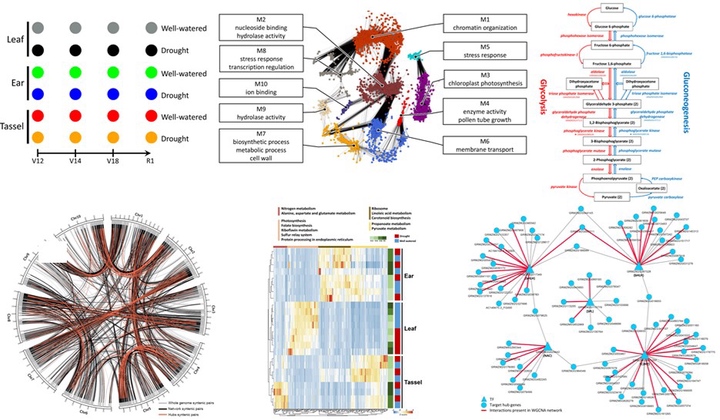A systems approach to a spatio-temporal understanding of the drought stress response in maize

Abstract
Crops are often subjected to periods of drought stress during their life cycle. However, how stress response mechanisms contribute to the crosstalk between stress signaling pathways and developmental signaling pathways is still unknown. We built a gene co-expression network from a spatio-temporal transcriptomic map of the drought stress response in maize (Zea mays), profiled from three tissues and four developmental stages and characterized hub genes associated with duplication events, selection, and regulatory networks. Co-expression analysis grouped drought-response genes into ten modules, covering 844 highly connected genes (hub genes). Of these, 15.4% hub genes had diverged by whole-genome duplication events and 2.5% might then have been selected during natural domestication and artificial improvement processes, successively. We identified key transcription factor hubs in a transcriptional regulatory network, which may function as a crosstalk mechanism between drought stress and developmental signalling pathways in maize. Understanding the evolutionary biases that have evolved to enhance drought adaptation lays the foundation for further dissection of crosstalk between stress signalling pathways and developmental signalling pathways in maize, towards molecular design of new cultivars with desirable yield and greater stress tolerance.
- 系统解析了玉米不同组织在生长发育和胁迫信号刺激下的关键基因的响应机制
植物一生中受到各种发育和胁迫相关的刺激信号,而它们通过错综复杂的信号通路和转录重编程来保证发育进程和抵抗胁迫的伤害。为了研究这一生物过程,寻找关键基因,我们利用共表达网络的方法对玉米干旱胁迫下的时空表达谱展开分析。我们在共表达网络模块中发现了800多个关键基因,进一步发现它们在进化中更加保守。同时,在玉米驯化改良过程中存在着对这些胁迫发育相关基因的正向选择。共表达网络和调控网络结合发现起关键作用的bHLH,NAC,C2H2等转录因子家族成员在玉米应答干旱胁迫和发育中扮演着双重重要角色。这项研究通过对玉米干旱胁迫下不同组织和发育时期基因表达的响应机制系统挖掘揭示了一系列进化,调控相关的枢纽基因。(Miao et al, Scientific reports, 2017)。